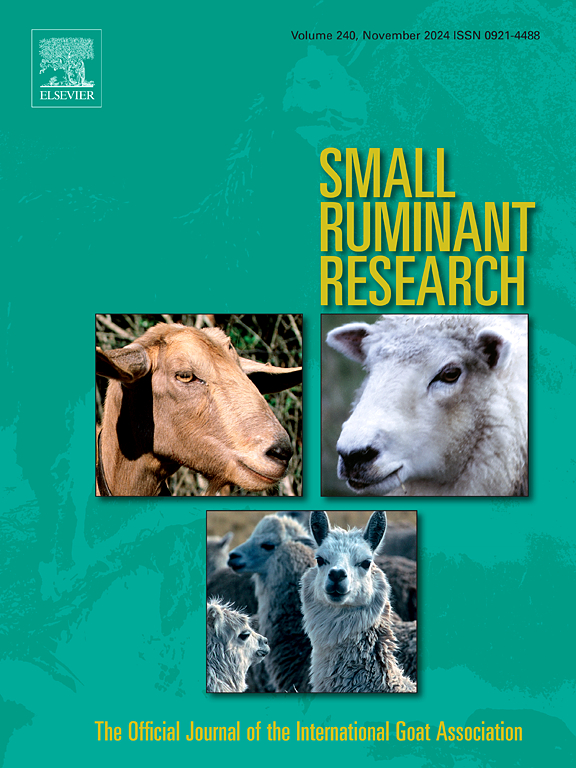求助PDF
{"title":"评估橘子油和苘麻干草对德赛尔母羊消化率和抗蠕虫药效的影响","authors":"Lorena Carmona-Flores , Marcelo Wallau , Catalina Cabrera , Joao Mauricio Bueno Vendraminid , Diwakar Vyas","doi":"10.1016/j.smallrumres.2024.107296","DOIUrl":null,"url":null,"abstract":"<div><p>Gastrointestinal nematode <em>Haemonchus contortus</em> is a major challenge for small ruminant production systems in the Southeast US. Alternative approaches to nematode control are needed to circumvent parasite resistance to chemical anthelmintic. The study aimed to evaluate the in vivo effects of orange oil (ORG) and sunn hemp hay (SH) supplementation on fecal egg counts, FAMACHA© and body condition score (BCS), hematological parameters, nutrient digestibility, and growth performance in Texel ewes. Forty-eight ewes (∼ 6 months; 31.3 ± 4.1 kg body weight) were orally dosed with 10,000 <em>H. contortus</em> larvae (L3 stage). Experimental pens (N=12; 4 ewes/pen) were blocked by low, medium, and high fecal egg counts. Treatments were arranged in a 2 × 2 factorial model with 2 levels each for SH and ORG. Treatments were: 1) Control: Pen receiving coastal bermudagrass based basal diet; 2) ORG: Pens receiving basal diet with orange essential oil; 3) SH: Pens receiving basal diet replacing 20% coastal bermudagrass hay with SH; 4) SH+ORG: Pens receiving SH with ORG. Experimental duration was 6 weeks including one week for adaptation and 5 weeks for data collection. Orange oil was orally dosed (600 mg/kg of body weight) once during week 1 of data collection. Data were analyzed using PROC GLIMIMIX of SAS with SH, ORG, and blocks as fixed factors while pen was used as random factor in the model. Fecal and blood samples, body weight, BCS, and FAMACHA© scores were collected once weekly. ORG was effective at lowering 37% of Strongylids (<em>including Haemonchus contortus</em>) egg counts in fecal samples while no effects were observed with SH. No treatment difference was observed on dry matter intake, and body weight (BW); while dry matter (DM), neutral detergent fiber (NDF), acid detergent fiber (ADF), and crude protein (CP) digestibility was lower in response to SH supplementation. In conclusion, ORG has anthelmintic potential; however, future studies should explore the mechanism and economic benefit of using ORG for small ruminant producers.</p></div>","PeriodicalId":21758,"journal":{"name":"Small Ruminant Research","volume":"236 ","pages":"Article 107296"},"PeriodicalIF":1.6000,"publicationDate":"2024-05-28","publicationTypes":"Journal Article","fieldsOfStudy":null,"isOpenAccess":false,"openAccessPdf":"","citationCount":"0","resultStr":"{\"title\":\"Evaluating the impact of orange oil and sunn hemp hay on digestibility and anthelmintic efficacy in Texel ewes\",\"authors\":\"Lorena Carmona-Flores , Marcelo Wallau , Catalina Cabrera , Joao Mauricio Bueno Vendraminid , Diwakar Vyas\",\"doi\":\"10.1016/j.smallrumres.2024.107296\",\"DOIUrl\":null,\"url\":null,\"abstract\":\"<div><p>Gastrointestinal nematode <em>Haemonchus contortus</em> is a major challenge for small ruminant production systems in the Southeast US. Alternative approaches to nematode control are needed to circumvent parasite resistance to chemical anthelmintic. The study aimed to evaluate the in vivo effects of orange oil (ORG) and sunn hemp hay (SH) supplementation on fecal egg counts, FAMACHA© and body condition score (BCS), hematological parameters, nutrient digestibility, and growth performance in Texel ewes. Forty-eight ewes (∼ 6 months; 31.3 ± 4.1 kg body weight) were orally dosed with 10,000 <em>H. contortus</em> larvae (L3 stage). Experimental pens (N=12; 4 ewes/pen) were blocked by low, medium, and high fecal egg counts. Treatments were arranged in a 2 × 2 factorial model with 2 levels each for SH and ORG. Treatments were: 1) Control: Pen receiving coastal bermudagrass based basal diet; 2) ORG: Pens receiving basal diet with orange essential oil; 3) SH: Pens receiving basal diet replacing 20% coastal bermudagrass hay with SH; 4) SH+ORG: Pens receiving SH with ORG. Experimental duration was 6 weeks including one week for adaptation and 5 weeks for data collection. Orange oil was orally dosed (600 mg/kg of body weight) once during week 1 of data collection. Data were analyzed using PROC GLIMIMIX of SAS with SH, ORG, and blocks as fixed factors while pen was used as random factor in the model. Fecal and blood samples, body weight, BCS, and FAMACHA© scores were collected once weekly. ORG was effective at lowering 37% of Strongylids (<em>including Haemonchus contortus</em>) egg counts in fecal samples while no effects were observed with SH. No treatment difference was observed on dry matter intake, and body weight (BW); while dry matter (DM), neutral detergent fiber (NDF), acid detergent fiber (ADF), and crude protein (CP) digestibility was lower in response to SH supplementation. In conclusion, ORG has anthelmintic potential; however, future studies should explore the mechanism and economic benefit of using ORG for small ruminant producers.</p></div>\",\"PeriodicalId\":21758,\"journal\":{\"name\":\"Small Ruminant Research\",\"volume\":\"236 \",\"pages\":\"Article 107296\"},\"PeriodicalIF\":1.6000,\"publicationDate\":\"2024-05-28\",\"publicationTypes\":\"Journal Article\",\"fieldsOfStudy\":null,\"isOpenAccess\":false,\"openAccessPdf\":\"\",\"citationCount\":\"0\",\"resultStr\":null,\"platform\":\"Semanticscholar\",\"paperid\":null,\"PeriodicalName\":\"Small Ruminant Research\",\"FirstCategoryId\":\"97\",\"ListUrlMain\":\"https://www.sciencedirect.com/science/article/pii/S0921448824001020\",\"RegionNum\":3,\"RegionCategory\":\"农林科学\",\"ArticlePicture\":[],\"TitleCN\":null,\"AbstractTextCN\":null,\"PMCID\":null,\"EPubDate\":\"\",\"PubModel\":\"\",\"JCR\":\"Q2\",\"JCRName\":\"AGRICULTURE, DAIRY & ANIMAL SCIENCE\",\"Score\":null,\"Total\":0}","platform":"Semanticscholar","paperid":null,"PeriodicalName":"Small Ruminant Research","FirstCategoryId":"97","ListUrlMain":"https://www.sciencedirect.com/science/article/pii/S0921448824001020","RegionNum":3,"RegionCategory":"农林科学","ArticlePicture":[],"TitleCN":null,"AbstractTextCN":null,"PMCID":null,"EPubDate":"","PubModel":"","JCR":"Q2","JCRName":"AGRICULTURE, DAIRY & ANIMAL SCIENCE","Score":null,"Total":0}
引用次数: 0
引用
批量引用


